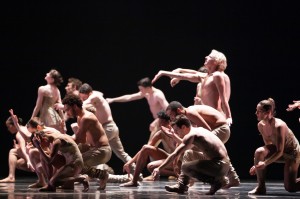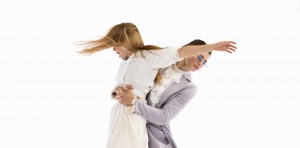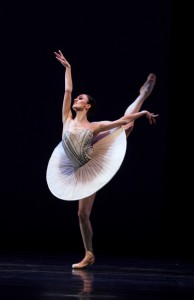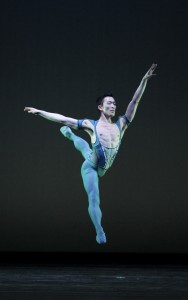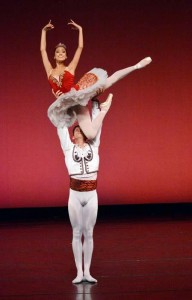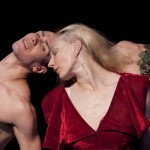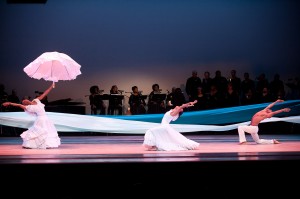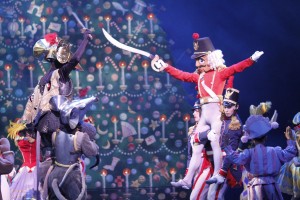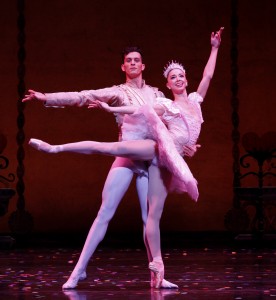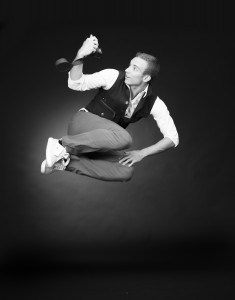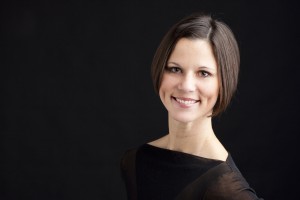
Hubbard Street 2 Director Taryn Kaschock Russell. Photo by Cheryl Mann.
On January 17th, Hubbard Street 2’s Artistic Director Taryn Kaschock Russell, rocked the Chicago dance world with this Facebook post: “After 17 amazing years in Chicago…I will be moving back to the east coast…”. You may think I’m being hyperbolic, but this petite powerhouse made a huge impact on the local dance scene. She will be missed. The impetus of the move comes via her husband Greg, who was recently named the new Company Manager for the New York City Ballet. “He started out at SAB (The School of American Ballet),” Kaschock Russell tells me over the phone from her West Loop HSDC office. “To be back managing the building that he learned in, some parts seem full circle.” The couple met while dancing with the Joffrey Ballet soon after the company made the transition to Chicago from New York in 1995.
Kaschock Russell grew up on the East Coast. She graduated high school early and planned on joining Boston Ballet II, but ended up at the Joffrey School in New York right before they declared bankruptcy – “It was a really amusing situation.” – and spent a year in NYC with her brother (dancing with David Parsons) and sister (on scholarship at Ailey). During her seven years at Joffrey, she made quite a name for herself in principal roles including the “Cowgirl” in Agnes de Mille’s Rodeo and as the first female outside of David Parson’s company to perform his six-minute, jump-laden solo Caught. In 2002, she joined Hubbard Street and was soon recognized as a “25 To Watch” in 2003 by Dance Magazine. After retiring from the stage, she began teaching and setting works for Hubbard St as part of the artistic staff – had a baby! – and in 2008, took over as director of the second company, HS2.
RB spoke with Kaschock Russell earlier this month about her career, leaving Chicago at the end of April and what’s next. Here are excerpts of our conversation:
First of all, I’m very sad, but happy for you too.
I know. It’s the same type of emotions I’m having too.
I know you from your Joffrey days. Let’s talk about Caught. Did your brother dancing for David Parsons have anything to do with you getting the part?
Yes and no. David knew me beforehand. I used to sit there and watch when it was only David doing the role. I remember sitting at City Center in the front wing when I was 15, watching David. I’m very proud of this story. I never went in and asked for anything, I didn’t believe in that. I believed in hard work and that should be acknowledged. But when I found great out that David was coming and that they were doing “Caught” that it was one of those opportunities in a career. So I said, I’m going to get my shit together and I’m going to go in during my lay off and I’m going to tell Mr. Arpino that I just want to learn it. I want to be in the room. I know that women can’t do it, but I want to be in the room and learn it. I walked in and they had the schedule up during lay off, before I went to talk to him, and there were three names on the list to learn it. It was Davis Robertson, Harris Jones and me. I never said anything! He just put me in there.
I have to say, seeing you do that solo was one of the coolest things I’ve seen in Chicago dancing. It was so awesome to see a girl do it. How hard was it? It was all jumps!
Thank you. It kicked my ass. Basically you have to keep jumping because you don’t know the timing of how the strobe works. It was a ton of trial and error. It is all jumping. After the first or second day, I’d blown out my quads. I had no idea what that was. I couldn’t walk up stairs. My legs kept giving out and then I’d have to go to rehearsal and they were like three-hour-a-day rehearsals. We would do it over and over again. I remember very vividly, he (David) pulled me aside after having me do something like ten more times than the guys did it and he said, “You just bought yourself a matinee missy, if this company will let me put a woman on”. It was really hard. First of all, it took a while to even have the stamina to do it. Still when I was in the wings before I went on, I would feel almost physically sick, because I knew how tired I would be at the end. At the same time, the audience experience is unreal. It’s like a rock performance. I knew that from watching him, but when you feel that and you’re on the stage and the whole audience freaks out that certainly ups the adrenaline. There’s that perseverance of I’m going to get through this.
You came to Hubbard Street in 2002. What made you switch?
I can’t believe I haven’t told you this story. One of the things I loved and was fortunate enough to grow up with was original creations, original choreography. At Joffrey, I got to do that a small amount, but it wasn’t happening quite as often. I had been watching Hubbard Street for years. We always traded tickets. The first inkling when I considered Hubbard Street was after I had just seen NDT’s (Nederlands Dans Theatre) performance of “Petite Mort” on an arts channel. It was the very first piece of choreography on television that made me cry. It was so beautiful and so unexpected and musical. I swear within a week of me seeing it, we got a newsletter at Joffrey saying that Hubbard Street had acquired “Petite Mort”! I remember freaking out. I went to see it and it was right after they’d learned it, so I think the company was still settling in to that kind of partnering, so the experience of watching it from the third balcony at the Shubert didn’t match how I felt watching NDT do it. I thought,ok, I’m still where I’m supposed to be right now. I was kind of getting a bug where I wanted to do more contemporary work, but I wasn’t there yet. Then I had a life-changing experience at Joffrey dancing “Appalachian Spring”. Yuriko Kikuchi came in to set it. The entire experience for me changed a lot of how I was viewing performance or what I get out when I’m learning. She was so giving. She’s very demanding, but so rich with information and not any part of that information felt selfish. She just wanted it to be ours and to watch it grow. It really was profound, the entire exchange and getting to dance that role and working with her. By the time I got to the stage, all I wanted to do was live in it and perform it in that way. I don’t think I’d experienced anything to that point. The process of learning it and putting it on stage was perfect in so many ways. At the same time, I was at a party with Cheryl Mann. She was going through the exact same kind of profound experience (at Hubbard Street). She said, “There’s this man, Ohad Naharin.” She started to describing the initial time he was there for “Minus 16”. The improvisation, pushing them outside their envelopes, telling stories, how he was using their vocals and everything that went into mounting that first “Minus 16”. So she and I made a pact. She was going to come see “Appalachian Spring” and I would go to see “Minus 16”. They had done “Petite Mort” in that program and then the last thing was “Minus 16”. That time “Petite Mort” floored me. I was in tears. The way they were dancing together was seamless. And “Minus 16” sealed everything. I think I looked at Patrick Simonello, who was with me, and said, “What am I doing with my life? And why am I not doing this?” It changed everything. I certainly had never thought of staying in Chicago. When you change companies, you normally move cities. I thought I’d go to Europe, or San Francisco or another ballet company. That performance just did it. That’s what I want to do with my life. I wanted to do the work, which made a huge difference and why I’m still here.
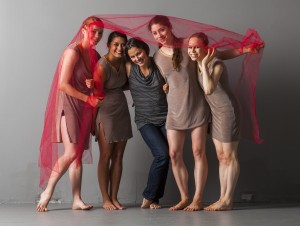
HS2 ladies: Emilie Leriche, Alicia Delgadillo, Taryn Kaschock Russell, Felicia McBride and Lissa Smith. Photo by Todd Rosenberg.
Tell me about the transition from dancing to artistic staff.
One of the reasons I stopped dancing specifically is that we were touring so much and I wanted to have a family and that wasn’t working out. It just wasn’t happening. I stopped dancing in December and within a month, Jim (Vincent) asked me to come back to set a piece. Julie (Nakagawa) and Andreas (Böttcher) had just resigned, so there was an interim year where HS2 had a rehearsal director and trying to figure out what to do. I set one piece on second company and shortly after they named me rehearsal director. It wasn’t a full-time contract. I didn’t go on tour, but when the company was here, I was here. Two months after I stopped dancing, I got pregnant. So I was rehearsal director and going back to school (studying Psychology at Northwestern) and pregnant. I really was crazy. I was responsible for remounting works from scratch. I started teaching class for the company. The transition was really smooth. Right after I had Donovan, they had a conversation with me about working with the second company. Basically, from the second I started working with the second company, it was history, because I just fell so in love. I came in the first day. My first group was with Jacqueline (Burnett, Hubbard St.) and Eduardo (Zuniga, Luna Negra) and Ethan (Kirchbaum, River North) How could you not fall in love with them? They were so hungry for information. I started giving corrections on a piece I already knew and the amount that it impacted them within 24 hours was so profound that I was floored. It was two things. It was exhilarating and beautiful and it was scary as hell. They will take what I say and it will mean this much to them. It will make an impact in their lives. The responsibility of it was overwhelming. It was the same way with becoming a new parent. The opportunity to impact lives in that way and help produce change that was meaningful for them. And to just give, in the same way, strangely enough, that I feel Yuriko had given to me. The way she gave to me made me want to give the same way to other people.
What is your teaching/mentoring philosophy?
I’m a little bit crazy. I’m not kidding. I make a fool out of myself every single day, multiple times a day. I’m so not self-conscious about who I am that they feel more comfortable being who they are and I make sure that can happen. I really, truly believe that HS2 needs to be a safe environment for exploration. I give this lecture every single year. You walk into that room and you are there to support each other. You support each others’ failures and successes. You root for everyone to succeed. Not everywhere is like that. I feel that the second company’s experience needs to be a place where they can try and fail in order to get to where they’re going to get to next. You have to fail. You have to fail in big ways and small ways and be able to try things that are ridiculous. The room is a safe room. I really look at everyone individually and try to develop groups that will work to feed off each other’s strengths and weaknesses. I would never want a group of individuals that is very similar, because there’s not enough diversity in the room to add. Everyone comes in with their own experiences and it adds to how everyone grows. They see each other change and I think it helps them. Nobody should want to leave two years later as the same person. They want to be transformed. My directing is trial and error. I’m trying things out. If it doesn’t work, I try other things. I don’t walk in with the answers. I walk in with every bit of information that I have and I give them everything that I have. Even if it’s “I don’t know”. I’m very honest. I try to be extremely honest about what their strengths and weaknesses are even when it’s hard. There are always difficult moments. It takes a lot of confidence on my own part to sit down and know that I’m not going to make someone hate me by saying something difficult. That’s growing up on my part. Laughter. Laughter is enormous. It’s allowing emotion to be shown. Our pieces are set up that they’re theatrical. They’re contemporary internal. They’re always asking for “you” to be in there. Your personality has to be in there. Especially for 18 to 25-year-olds, that can be super uncomfortable. Allowing the time to be ridiculous and silly in that safe atmosphere. You need to be somewhere where you aren’t judged for trying.
What advice would you give to the next director of HS2?
Allow yourself to be changed. Observe and learn from the people you’re directing. People learn from example. I love the education outreach we do. I believe in it so wholeheartedly. My love for those things goes to my dancers. My willingness to think outside the box in situations and create site-specific improves so they look the best. As I open my mind to things, their minds are open as well, because they see the person in front of the room be excited and inspired. Also, believing the dancers are really special. They are special and they are worth serious investment. Each group of them will change. Adapt to your companies and leading them with strong examples without fear. If you’re asking them to give all of that to you and to create a safe environment, then you have to do it too. You have to lead by example.
What’s in your future in New York?
One of the things I’d like to do is stop touring. He’ll be touring some, so I want to take the opportunity to be the one not leaving. I’ve been fortunate to be able to have worked with a lot of choreographers and NYC isn’t a small dance town. I’ve developed some friendships. I’ve put out some feelers at university programs. That age group fascinates me because they want to learn. But I would be lying if I didn’t say some of the companies there would be interesting to work with. I’m not going towards one thing there. I’m looking forward to spending a little time and teaching in different places and figuring out what might make the most sense. I’m pretty non-committal. My first priority is getting settled and finding where we want Donovan to be in Kindergarten.

